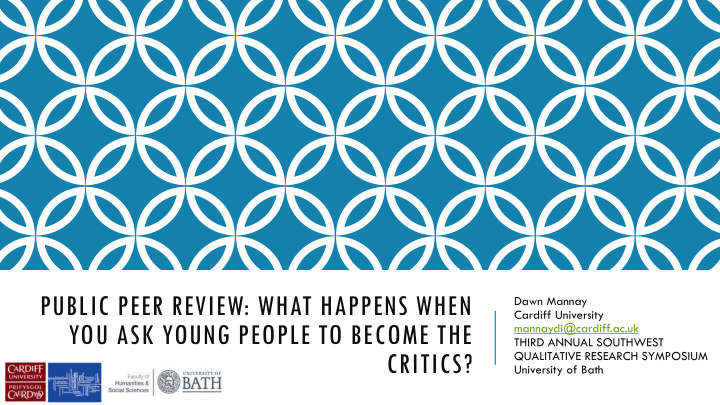



PUBLIC PEER REVIEW: WHAT HAPPENS WHEN Dawn Mannay Cardiff University YOU ASK YOUNG PEOPLE TO BECOME THE mannaydi@cardiff.ac.uk THIRD ANNUAL SOUTHWEST CRITICS? QUALITATIVE RESEARCH SYMPOSIUM University of Bath
OUTLINE Academic products Academic conventions Beyond text New voices New critiques Multimodal messages
OUR CHANGING LAND
ACADEMICS TALKING TO ACADEMICS Traditionally ‘referees and editor have judged the work submitted to them for publication’ (Becker 2007, p.287) Difficult to move beyond the dry, flat prose that forms a ‘linguistic armour’ in much academic writing (Lerum 2001) Much academic dissemination is positioned as passive and designed to accrue the most significant benefits to the researcher, rather than engendering wider value (Groundwater-Smith et al. 2015)
NO BEST WAY TO TELL A STORY ABOUT SOCIETY ‘there is no best way to tell a story about society… instead of ideal ways to do it the world gives us possibilities among which we chose’ (Becker 2007 p. 285) ‘beyond text’ approach to dissemination (Beebeejaun et al 2014) imaginative ways of reporting can communicate research findings to a wider public and different forms reach different audiences (Silver 2016) important to consider how researchers can mediate ‘vigorous research through a creative format to increase impact’ (Mannay 2013, p.134 ) Who should tell the story? How should it be told? Can it be heard?
PHOTOGRAPHY, FILM AND MUSIC University of Wales Press Ministry of Life, Ian Homer, Nathan Bond Asked young people their views? Is this right? What’s missing? What messages do you have?
WALES, WELSHNESS, LANGUAGE AND IDENTITY https://www.youtu be.com/watch?v=l ECT5lxl7os
https://www. EDUCATION, LABOUR MARKETS AND youtube.com /watch?v=A 93uWd6FAjc GENDER IN WALES
WELSH PUBLIC LIFE, SOCIAL POLICY, CLASS AND INEQUALITY https://w ww.youtub e.com/wat ch?v=KOr PYVXq32I
CONCLUDING REMARKS Moving beyond the academic article Exploring unconventional critiques Engaging differential form of authentic voice Political, personal and practice based audiencing Impact and engagement funding opportunities
DIOLCH I CHI AM WRANDO
REFERENCES Becker, H. S. 2007. Telling about society . Chicago: University of Chicago Press. Beebeejaun Y, Durose, C, Rees, J, Richardson, J, Richardson, L, 2014, Beyond text: Exploring ethos and method in co-producing research with communities, Community Development Journal 49 (1): 37 – 53. Groundwater-Smith, S., Dockett, S. and Bottrell, D. 2015. Participatory research with children and young people . London: Sage. Lerum , K. (2001) ‘Subjects of desire: Academic armor, intimate ethnography and the production of critical knowledge. Qualitative Inquiry 7 (4): 466 – 83. Mannay, D. 2016. Visual, narrative and creative research methods: application, reflection and ethics . Abingdon: Routledge. Mannay, D. ed. 2016. Our changing land: revisiting gender , class and identity in contemporary Wales . Cardiff: University of Wales Press. Mannay, D. 2016. To understand what young people think, speak their language. The Conversation . 6th September 2016. https://theconversation.com/to-understand-what-young-people-think-speak-their-language-63556 Silver, D. 2016. Telling ‘About Society’ for Public Sociology. Presented at Visual Innovation: A Methods Workshop #Visual16 . BSA Postgraduate Forum & Visual Methods Study Group. Staffordshire University 22 November 2016.
Recommend
More recommend